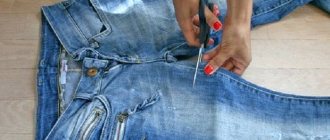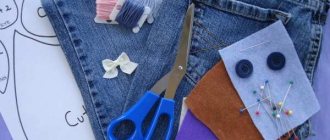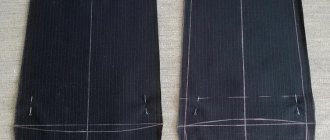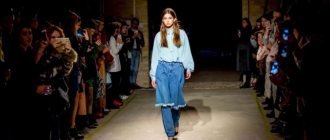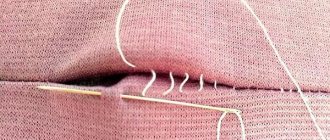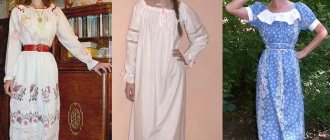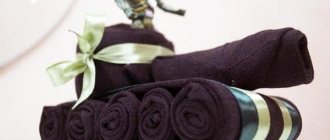At home, you can shorten your trousers without cutting off the factory seam. We'll tell you how to do this now.
Step 1
Measure the length of the trouser legs and pin them. Try it on again and make sure everything is correct.
Step 2
Connect the new line with the factory stitch so that you get a fold on the wrong side. The distance along the entire length should be the same, the side and internal seams are connected evenly.
Step 3
Now stitch as close to the factory seam as possible. Cut the fold at the back and overcast the edges by hand or with a machine.
Step 4
Before trying on, iron the seam allowance up so that it does not interfere with walking. The jeans are hemmed!
Which jeans look fashionable with a cropped hem?
Any pair of jeans can become a fashion accessory if you follow a few simple cutting rules. The table shows the main types of jeans and options for transforming them by shortening the length.
| Jeans type | Type of transformation |
| Flared |
|
| Direct |
|
| Tapered |
|
Achieving a stylish casual effect when cutting jeans depends on the type of fabric they are made from.
You can create a beautiful fringe only from natural rough denim that does not have elastane (or its content is less than 50%). Stretch jeans will look great with the stitching still in place or with a raw hem that has a slightly fluffy, casual look.
More often, to transform jeans, they choose plain models in classic colors (black, blue, light blue). Fringe and various slits on colorful jeans will not look expressive. At the same time, following the trend of the season, jeans with small prints, having a raw hem and contrasting details, are becoming popular.
Hemming trousers using adhesive tape
An excellent tool if you need to shorten jeans is adhesive tape. It allows you to achieve the desired length without cutting the bottom.
Sewing adhesive tape is a unique subtype of double-sided tape, which, when heat treated, is converted into glue and allows you to reliably connect two pieces of fabric. Moreover, the temperature required to achieve success can be achieved without problems using a standard iron with a steamer.
Procedure:
- Find special adhesive tape in the store and purchase it. It is usually sold by the meter, so you can take some stock.
- Mark the jeans along the length.
- Place the tape between the layers of folded fabric.
- Iron the material using the steam function. To ensure the safety of the material, an intermediate damp cloth can be used. It is very important to apply high pressure to the surface to melt the tape and connect the fabric elements.
- Give the product some time to cool, then check the strength of the connection.
It is worth noting that the final result directly depends on the quality of the adhesive base, the pressing force and the characteristics of the particular jeans.
Who is the marginal denim style suitable for?
Marginal style in denim suits absolutely everyone, regardless of age, height and gender. The essence of style comes down to convenience and personal worldview. Such people value comfort in clothing and the need to protect the body from the cold.
Marginal denim is very popular among people of all social levels. Things that look sloppy are often made of high-quality and expensive materials. The main element of clothing in a marginal style is plain, faded, torn jeans, with patches and scuffs.
Fashionable decor options for shorts made from cut-off denim trousers
The decor distinguishes and highlights the design idea. It’s easy to get a fashionable and stylish item by adding original elements. Decorate the shorts with curly cuts on the back pockets or front, additionally gluing them with non-woven fabric on the reverse side.
The shorts turned out too short - no problem. Cut out stars from the remaining jeans, turn them wrong side out and overlap the edges.
Change the fabric of the inner front pockets to a bright one and it will playfully peek out from under your shorts. Add small details to match the tone.
You can sew lace or fabric with a Provence style pattern onto the back pockets. Such elements will emphasize the fragility and femininity of the owner.
A quick option to change shorts is embroidery with threads or sequins on hot glue. Place the decor on the shorts, place a sheet of paper on top and iron with a hot iron.
Necessary tools for cutting jeans
A supply of imagination, a moment of experimentation and a number of available tools will help you cut your jeans at the bottom in a fashionable way:
- manicure scissors;
- tailor's scissors (large stationery scissors);
- ripper;
- chalk (pencil);
- tailor's pins;
- threads;
- tweezers;
- sandpaper (sharpening stone);
- iron;
Stitch seam
It is very convenient to shorten jeans using a sewn seam. How to do this correctly?
The stitch seam is made without gaps. The needle is inserted into the exit of the previous stitch. The direction of the seam is from right to left. The thread should be in the middle.
- Insert the needle to the right of the thread at a distance of 5 millimeters.
- On the left, bring it out at the same distance. You will get a beautiful stitch.
- After this, insert the needle into the beginning of the stitch. Output 5 millimeters to the left of the thread.
Preparatory work
When transforming your favorite jeans, your body shape and season trends are taken into account. The most important step when cutting jeans is to accurately determine the desired length of the product.
Preliminary steps to be performed before starting work:
- The style in which cropping is expected is determined. Viewing photos on the Internet and studying the characteristics of your own figure will help you make the right choice.
- Selected jeans are pre-washed. Natural denim shrinks slightly after washing. If you cut off unwashed, worn-in jeans and then wash them, you can get a result that differs from what was originally intended. For example, the length of the product and the length of the fringe will become shorter.
- The necessary tools are being prepared.
- The desired length of the trouser legs is determined in front of the mirror and a mark is made with a pencil or chalk.
How to cut denim at the bottom in a fashionable way? Options and step-by-step description Season trends suggest current solutions for creating fashionable jeans, shorts and breeches.
Basic Rules
Studying the rules will help you do your work without any marks, and the appearance of your jeans neatly.
- Before sewing, the product must be washed and ironed so that there are no folds or creases.
- Jeans should be measured first from the wrong side to mark the folds, then from the front.
- The fitting should be with the shoes with which you will wear this model. Trousers should not be gathered or accordion-folded.
- Before sewing, the pants should be laid out on a flat surface, the waistband, inner and outer seams should be pinned together.
- Denim should be cut with sharp scissors (these are sold in sewing stores).
- The threads and needle must be of the appropriate color and size.
- To flatten thick areas, you need to tap them with a hammer.
- If the machine cannot cope with thick fabric, then it is better to hem it by hand. Make sure the stitches are neat and don't jump.
- Open edges should be sergeed, otherwise they will quickly unravel and hang fringed.
- After finishing sewing, the jeans need to be ironed again.
Beautiful with factory stitching preserved
Sometimes the style of clothing does not allow for negligence. In this case, a good solution for creating an original look would be to shorten the length of the jeans while maintaining the stylish factory stitching.
You can cut the bottom of jeans in a fashionable way by following the following procedure:
- The length of the trouser legs is determined and a mark is made with chalk or pencil.
- The line of the new length is combined closely with the factory hem so that a fold is formed on the wrong side, and on the front side the jeans look like they have been processed in a factory. The fold is fixed with tailor's pins and basting is done with thread.
- From the inside, a machine or hand stitch is laid along the basted line.
- Excess fabric is trimmed at a distance of 1.5 cm from the new seam.
- Sections are processed with an overlock or overlock stitch.
- Using an iron, the seams are steamed, the factory hem is straightened down, and the seam cuts are straightened up.
Shortening jeans at home
When you hem trousers yourself, the seam is very different from the factory seam, not for the better - it becomes flat, there is no frayed effect. Knowledge of special techniques allows you to achieve stitch quality that is as close as possible to factory stitching.
Materials
- Chalk or piece of dry soap;
- Tailor's scissors;
- Hammer;
- Threads with needles;
- Ruler;
- Polyethylene;
- Flat brush;
- Acrylic paints.
Step-by-step instruction
- First, put on the jeans and mark the desired length on one leg with chalk.
- The edges of the belt are aligned and secured with tailor's pins.
- The trouser legs are straightened and leveled, secured with pins slightly above the mark.
- Draw a straight line with chalk along the level of the mark; the drawn strip should be perpendicular to the stitched line.
- Select the distance required for the allowance.
- Mark, draw a line, and cut off the bottom cut with scissors.
- Take out the pins.
- Thick places are cut off.
- The sections are folded inwards, basted, folded again and stitched on sewing equipment.
- Stitch the bottom at a small distance.
- Polyethylene is laid on the surface of the table, and jeans are placed on it.
- Using a spray bottle, spray the hemmed bottom of the pants, avoiding getting too wet.
- Hem threads are matched to the color of the denim.
- It is also advisable to use paint that matches the tone as closely as possible.
- Apply color to the stitching area on the back and front sides and allow time to dry.
To create abrasion, take a needle and thick thread and sew stitches 0.5-0.7 cm long along the line by hand. A similar operation is carried out along the bottom edge.
Re-lay the jeans on the table surface and spray with water from a spray bottle. Apply light paint with light brush movements to the front and back edges. Allow time to dry completely, after which the thread is removed.
The jeans look very impressive and have a worn effect along the bottom edge.
For the length of breeches or shorts
For these purposes, you can choose any out-of-fashion jeans that fit your figure well. For knee-length breeches, both tapered and straight models are suitable. It is good to use stretch and natural cotton jeans at the same time.
Important points when cutting jeans to shorts length:
- for classic and short shorts, it is better to use only natural denim, since elastic fabrics pinch the thigh, which does not look aesthetically pleasing;
- when planning the length, it is better to leave an extra 2 cm and then cut it off if necessary, rather than immediately cutting it too short;
Work order:
- Selecting product length. When planning hems or cuffs, an allowance of approximately 7 cm is left. If fringe is planned, an allowance of at least 2 cm is left. Appropriate markings are applied with a pencil.
- Using sharp scissors, cut to the required length, taking into account allowances.
- The product is being tried on. A decision is made to process the bottom. Perhaps, when trying on, the desire to make a fringe will change to a desire to bend the bottom of the product or make a lapel. Depending on the decision, the length of the shorts or bridge is adjusted.
- The bottom of the product is processed.
Bottom processing options may vary:
- With a lapel. The bottom is turned over twice to the front side of the product, the bend of the desired width is fixed with a steam iron.
- With a hem. The lapel is made inside the product and stitched on a sewing machine or with a hand stitch.
- With fringe. Fringe can be obtained in different ways. You can rub the edges against each other, imitating the motion of hand washing.
You will get a light, neat fringe. Also, by pulling the threads with tweezers, you can get a longer, stylish fringe. This creates a more natural, messy look with a jagged edge. Washing in the machine also gives a good result in creating a fringed edge.
How to shorten jeans by hand without a machine
Shortening trousers without a sewing machine will not take very long. The main thing is to correctly determine the desired length.
Step 1
Try on the pants, mark the hem with chalk, soap or pins.
Step 2
Turn the product inside out, make a mark just below the first one (2 cm), remove all the pins. Make sure both legs are symmetrical.
Step 3
Cut to the desired length, fold inward, and secure the edge with pins. Hem both legs with a hidden seam. Make sure the stitches are even.
With a jagged raw edge
You can cut jeans in a fashionable way using the trend with an asymmetrical raw edge. A distinctive feature of the method is that the length of the front part of the trouser leg is shorter than the back part. For transformation, both straight and skinny jeans are used.
Work order:
- The bottom factory edge is cut off.
- The product is tried on and the length of the front and back of the legs is determined. Jeans that reveal the ankle look great.
- Markings are applied with a pencil on both legs.
- Using sharp scissors, cut off the edges of the front and back panels of the jeans.
Types of processing of the front part of the trouser leg:
- straight horizontal cut;
- cut at an angle of 45°;
- triangular cutout in the middle of the front;
- torn front cut;
- wavy front cut;
The back part is often cut horizontally. Both parts of the legs are not processed, leaving a slightly fringed edge.
When shortening jeans in this way, you don’t have to be afraid to make an uneven line, since style lies precisely in the deliberately careless cut of the bottom of the legs.
Hemming by hand
You can shorten jeans to the desired length without using a sewing machine. In this case, most often they do not resort to cutting the legs. This will be especially useful for those girls who wear one pair of trousers with heels of different heights. The length adjustment process includes the following operations:
- Use tailor's chalk to mark the hem line on the trouser material.
- Iron the seam allowance, applying it to the wrong side of the product.
- Turn the trousers inside out and carefully sew the bottom part to the side seams. Here it is important to use the smallest possible stitches that will not be noticeable.
The result will be jeans of the desired length. This hemming method is temporary and does not involve any finishing stitching. This is why you can do without a sewing machine.
It is also worth noting another method that does not involve the use of sewing equipment. It involves gluing the material using high-quality glue. “Moment” is best.
It is necessary to mark the required length of the jeans and cut off the excess allowance. Next, the allowance is glued along the first fold line. The glue layer should be small so that no difficulties arise during the operation of the trousers. It is recommended to iron the resulting fold immediately.
Similarly, the folded edge is glued along the marked line from below, after which final fixation is carried out using an iron.
This type of processing will not allow you to get the most beautiful and accurate result at the end, but it does not require a sewing machine and can be carried out in a short time.
With wavy bottom
Cutting jeans to create a wavy hem, as one of the newfangled trends, occupies a leading position.
Visually, such an edge looks like an alternation of the main fabric of the trouser leg with loose gaps that are filled with horizontal white denim threads.
Through this alternation, a stylish effect of a torn, careless bottom is created. You can make only one loose section with elongated threads in the middle of the front of the trouser leg, you can alternate. It is not recommended to make too narrow gaps between loose areas. It is optimal to leave 3-4 cm.
Execution order:
- The length of the jeans is determined. The length of the front and back panels of the trouser legs may be different. To do this, follow the same steps as for obtaining jeans with an uneven raw edge. Markings are made with chalk or pencil.
- Excess edges are cut off with sharp scissors.
- The distances between the loose spaces are marked. The width and height of the spaces with elongated threads are determined. Marks are made with a pencil.
- At the designated intervals for spaces with elongated threads, 3-4 horizontal parallel cuts are made at a distance of 1 cm. Small parallel ribbon-like strips are obtained. From them, using tweezers, the main (vertical) threads are pulled out. As a result, there should be gaps filled only with white horizontal denim threads.
- Washing your jeans will give a natural, casual effect.
Required materials and tools
To exactly replicate factory processing, you need an industrial machine. Most home sewing machines do not sew through multiple layers of denim. It’s good if you still have an unpretentious machine from your grandmother, it will do the job better than modern “seamstresses”. In addition to heavy equipment, you will need:
- sharp scissors, ideally tailor's No. 12;
- machine denim needles No. 100-130;
- threads to match the fabric No. 40 and finishing threads No. 20;
- tailor's chalk or regular soap;
- iron with steam.
A short list will be useful for performing the most technologically advanced hems on a home sewing machine.
With fluffy short fringe
Absolutely any jeans are suitable for alteration, including flared jeans and models with elastane.
The process of doing the work is very simple. The main thing is to outline the desired length, leave an allowance (1-2 cm), trim off excess edges with scissors and make a small fringe using one of the following methods:
- Rub the slices against each other, imitating the motion of hand washing.
- Using a thick needle, tweezers or nail scissors, pull out the main horizontal threads until the fringe reaches the desired length.
- Rub the sections with pumice, a grindstone or sandpaper to obtain a short, fluffy fringe.
- Wash the item in the washing machine to obtain a natural, classic fringed edge.
- Sew finished fringe in a contrasting color along the edge.
How to lengthen jeans
Our advice will help in situations where the trousers have shrunk after washing, the child has grown, and the trousers have become a little short. You can take it to a studio or save money and increase the length at home.
Wet
If you don’t want to bother with sewing, you can try stretching wet jeans. First you need to wash them.
- Fill the bathtub with water, dissolve one capful of baby shampoo, and stir. The liquid should be warm, never hot. Immerse the jeans in there and let them lie in the soapy solution for half an hour.
- Take it out of the water and wait for the water to drain. Don't twist them. After this, wrap the trousers in a terry towel to make a “roll”. Squeeze the fabric to absorb the water into the towel. Change to dry as needed.
- When most of the liquid has been absorbed, pull the fabric down from the waistband. Don't make sudden movements. After reaching maximum tension, leave to dry in a horizontal position.
Do not miss
- Do not miss
Whether it fits or not: how to stretch jeans at home
Decorative finishing
You can lengthen women's or children's pants by trimming them with fringe, frill, lace - there are many options. Sew the decorative element underneath or over the factory seam. But by betting you can not only increase the length, but also the width. To do this, open the inner seam and lice a triangular piece of fabric.
Adjustment
This method can actually lengthen your trousers by up to 2.5 cm.
- Open the factory seam using sharp scissors and pull out all the threads. This is good to do while the trousers are new and there is no strong contrast.
- Wash, dry as usual, iron the fabric so that there are no creases or folds.
- Try on the desired length of trousers. If you increase the width of the entire hem, you will have to sew a piece of fabric or braid to the edge.
- Machine stitch the fabric and the edge of the trouser leg, try it on again, pin the hem.
- Tuck the fabric, iron it, blind stitch it by hand or machine stitch. You can make a hem using a web tape.
With long fringe
Stylists suggest cutting jeans at the bottom in a fashionable way in the form of a hem with a length of fringe to create a street look. For work, jeans made from natural denim are chosen. The fringe on these jeans will be perfect.
The procedure is as follows:
- The length of the trouser legs and the length of the fringe are determined. The corresponding markings are applied to the trouser legs with a pencil or chalk.
- The edge is cut with scissors, taking into account the allowance for the fringe.
- The fringed cloth is cut into vertical strips, each approximately 1 cm wide.
- Using tweezers or a thick needle, horizontal threads are pulled out of the strips. There should be long free threads of vertical rows.
- The fringed edge can be combed, tied into tassels, or tousled with sandpaper.
Despite the variety of fashionable, branded designer jeans, everyone can create a unique pair for themselves by stylishly cutting the hem and bringing their unique look to life.
Article design: Vladimir the Great
Preparing to Hem Jeans
It is worth noting that without much effort or equipment you can shorten and hem medium-weight denim and thin materials.
Jeans made from thick fabrics can cause problems. In this case, it is more advisable to immediately contact a studio that has professional sewing equipment.
Immediately before performing the operation, you need to determine the required length of the trousers. Moreover, for female models it may be more difficult to determine this indicator than for male ones.
To find out the required length of jeans, you need to put on your shoes and stand up. Then a mark is placed, based on which all further manipulations will be carried out.
Men most often wear shoes with flat soles or low heels. Women often exchange sneakers for shoes with a high bobbin and vice versa. Accordingly, the required length of trousers will be different for each case. However, the shortened models that are fashionable today are much easier to hem.
It is better to measure length individually for each leg, since almost every person has some physiological asymmetry. Pants should be quite comfortable both when wearing and sitting.
Jeans repair: how to hem frayed bottoms?
Denim, although practical, is still short-lived and tends to fray.
For example, jeans have “weak” places: between the legs and at the bottom. Why do my jeans fray quickly at the bottom? There are several reasons, one of the most common is that the trousers are too long. Basically, frayed edges of denim are always in fashion, especially among young people, but if you have classic denim trousers, it is still better to repair them and give them a neat look. To hem the frayed bottom of your jeans, you don't have to go to a seamstress. If you have a sewing machine, repairing the bottom of your jeans will take you a maximum of half an hour.
We repair jeans ourselves.MK
We repair the bottom of denim trousers with our own hands
If your husband told you today that he needs to buy new jeans because the old ones are torn, don’t believe him :)) Inspect the property urgently! Not your husband, of course, you know him like the back of your hand! Jeans! Twist, twist and find a solution that works for you.
We do the repairs ourselves.
It is not necessary to announce this to your husband. Smile mysteriously, gently and affectionately answer: “Okay, honey, I’ll think about it tomorrow.”
Today, send your husband to watch a new film, and get down to business.
Get it done faster than the movie ends.
Let's get to work.
The whole process is in the attached images.
If you don't understand, ask.
Savings are in your favor.
If you used the services of an atelier, you would need an amount equal to the cost of 2 skeins of thread.
If we bought new ones... xxxxxxxx.
Profitable? So learn how to repair clothes yourself.
And this is your saved money :)))
| 2. Iron the trouser tape, moistening it.
10.From the wrong side, you can fasten the hem by hand at the crotch seams.
Source
